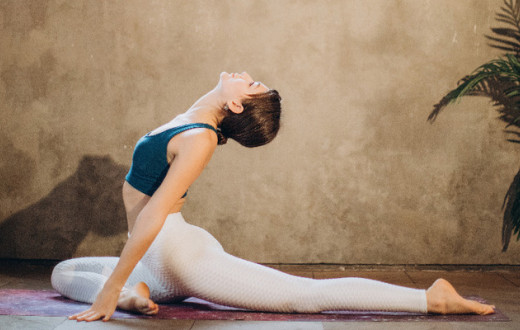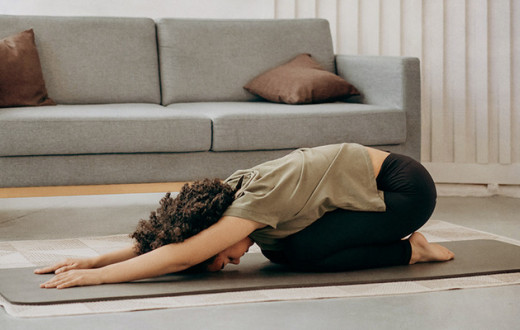Eka - One, Pada - foot, Raja - King, Kapot - Pigeon, Asana - pose
How to pronounce: Ache-aa-Pahd-uh-Rah-jah-Capote-aas-un-uh
Eka Pada Raja Kapotasana is a yoga posture suitable for intermediate level yoga practitioners. It is known to improve the flexibility of the hip muscles and aids in relieving sciatica.

Before you sit in this posture, do some simple warm-up asanas that will make the stretch easy and comfortable for the body.
Preparatory poses of the One-legged Pigeon Pose or Eka Pada Raja Kapotasana
- Seated Forward Bend (Paschimottanasana)
- Butterfly Pose (Badhakonasana)
- Parsvottanasana (Intense Side Stretch Pose)
- Gomukhasana (Cow Face Pose)
How to do One-legged Pigeon Pose (Eka Pada Raja Kapotasana)
- Begin by getting into the Cat Stretch (Marjariasana).
- Breathe out and bring your right knee forward to touch the right wrist.
- Bend the knee, and bring your ankle near the groin region. Now, slide the right foot towards the left hand, till the toes touch the left wrist.
- Slide the left leg back so that it touches the floor. Keeping the knee straight, ensure that the front of the foot is touching the ground, while the sole faces the ceiling.
- Lower your right buttock to the floor and press your tailbone forward to lengthen your lower back.
- You may strengthen the lower back further by pushing your fingertips firmly to the floor.
- Take a few deep breaths in this position.
- Taking support of your hands, slide your left knee forward while exhaling and get back into the Cat Stretch.
- Stay in the Cat Stretch pose and take a couple of deep breaths and repeat the process with the other leg
One-legged Pigeon Pose (Eka Pada Raja Kapotasana) for beginners
If you are a beginner, it would help you to fold and place a blanket or place a yoga block below your groin region to support the body while doing the Eka Pada Raja Kapotasana. Over time and with practice, you will feel comfortable with the pose and will be able to maintain it naturally without these supports.
Benefits of the One-legged Pigeon Pose (Eka Pada Raja Kapotasana)
Eka Pada Raja Kapotasana has several benefits:
- stretches the entire lower part of the body
- stimulates the abdominal organs
- strengthens the back
- improves posture
- helps relieve the body of sciatica
- helps open up the hips, making the hip region more flexible
- relieves the body of stress and anxiety
- opens up the chest region making you feel energetic and confident
Contraindications of the One-legged Pigeon Pose or Eka Pada Raja Kapotasana
Some people should avoid doing this pose in these conditions:
- Those with ankle or knee injury
- Pregnant women
- Those with a weak digestive system
- Those with pelvic or groin injuries
Also, perform this pose only under the supervision of an experienced teacher.
Follow-up poses of the One-legged Pigeon Pose or Eka Pada Raja Kapotasana
You may follow up this pose with these asanas:
- Sitting Half Spinal Twist (Ardha Matsyendrasana)
- Downward Dog Pose (Adho Mukha Svanasana)
- Monkey Pose (Hanumanasana)
View All - Sitzende Yoga Asanas
<<Butterfly Pose Child Pose >>
Yoga practice helps develop the body and mind bringing a lot of health benefits yet is not a substitute for medicine. It is important to learn and practice yoga postures under the supervision of a trained Sri Sri Yoga teacher. In case of any medical condition, practice yoga postures after consulting a doctor and an Sri Sri Yoga teacher. Find an Sri Sri Yoga program at an Art of Living Center near you. Do you need information on programs or share feedback? Write to us at info@srisriyoga.in
FAQ's on Pigeon Pose
"Practice the following steps to do Eka Pada Raja Kapotasana *Start with Cat stretch *Bring your right knee forward to touch the right wrist. *Bend the knee, and bring your ankle near the groin region. Now, slide the right foot towards the left hand, till the toes touch the left wrist. *Slide the left leg back so that it touches the floor. Keeping the knee straight, ensure that the front of the foot is touching the ground, while the sole faces the ceiling. *Lower your right buttock to the floor and press your tailbone forward. *You may strengthen the lower back further by pushing your fingertips firmly to the floor. *Take a few deep breaths in this position. *Taking support of your hands, slide your left knee forward while exhaling and get back into the Cat Stretch. *Stay in the Cat Stretch pose and take a couple of deep breaths and repeat the process with the other leg."
"Benefits of Kapotasana: stretches the entire lower part of the body stimulates the abdominal organs strengthens the back improves posture helps relieve the body of sciatica helps open up the hips, making the hip region more flexible relieves the body of stress and anxiety opens up the chest region making you feel energetic and confident"
Eka Pada Raja Kapotasana is a yoga posture suitable for intermediate level yoga practitioners.
"King Pigeon Pose is hard or intense only for those whose hips are tight and stiff. This pose improves the flexibility of the hip muscles and aids in relieving sciatica. Fold and place a blanket or place a yoga block below your groin region to support the body while doing King Pigeon pose for the initial days. Before sitting in this pose, few warm-up asanas are recommended like Seated Forward Bend (Paschimottanasana) Butterfly Pose (Badhakonasana) Parsvottanasana (Intense Side Stretch Pose) Gomukhasana (Cow Face Pose) "
People who sit for a long period, King Pigeon is good as it is a great hip opener. It makes the hip region flexible.
"To practice Kapotasana follow these steps: *Start with Cat stretch *Bring your right knee forward to touch the right wrist. *Bend the knee, and bring your ankle near the groin region. Now, slide the right foot towards the left hand, till the toes touch the left wrist. *Slide the left leg back so that it touches the floor. Keeping the knee straight, ensure that the front of the foot is touching the ground, while the sole faces the ceiling. *Lower your right buttock to the floor and press your tailbone forward. *You may strengthen the lower back further by pushing your fingertips firmly to the floor. *Take a few deep breaths in this position. *Taking support of your hands, slide your left knee forward while exhaling and get back into the Cat Stretch. *Stay in the Cat Stretch pose and take a couple of deep breaths and repeat the process with the other leg."""
Utthan Pristhasana, Lizard pose, is a hip opener variant with the forearms on the floor. Moving the front foot onto its side so the knee comes to the ground enables a transition to a related backbend, Rajakapotasana. In Sanskrit, uttan means stretch deep out, pristha means back of the body and asana means posture.
People having ankle or knee injury, pregnant women, weak digestive system, pelvic or groin injuries should avoid Pigeon pose. Also, perform this pose only under the supervision of an experienced teacher.
"Cobra stretch or Bhujangasana is included in Suryanamaskar (Sun Salutation) as well as in Padma Sadhna. Procedure: *Lie on stomach with toes flat on floor. *Legs are close to each other. *Palms are touching ground under your shoulders, elbows should be parallel and close to your torso. *Take a deep breath in, slowly lift your head, chest and abdomen. Navel touching the floor. *Pull your torso back and off the floor with the support of your hands. Put equal pressure on both the palms. *Keep breathing with awareness, as you curve your spine, vertebra by vertebra. If possible, straighten your arms by arching your back as much as possible; tilt your head back and look up. *Maintain the pose. Breath in 4-5 breaths. *Breathe out, and gently bring your abdomen, chest, and head back to the floor and relax. *Repeat 4-5 times."
Mermaid pose is an advanced posture that involves an intense twisting backbend and hip/heart opener. This is a variation on the traditional one-legged king pigeon pose (eka pada rajakapotasana). Mermaid pose provides a deep and energizing stretch for the chest and shoulders, as well as for the groin and thighs. This asana stimulates the internal organs and works the core muscles. It is a bit easy for the beginner as it doesn't require as much strength and flexibility.
People who sit for a long period at a stretch tend to have tight hips. The hip region is said to be the house of creative energy and sexuality. When stress gets trapped here, emotional instability occurs like - fear, trauma, sadness, worry. Doing the hip opening asanas relieves you from these emotions.
"We should avoid asanas which put a lot of pressure on the knees and its painful to you *Knee rotation *Utkatasana *Vir bhadrasana *Vajrasana *Ashwa sanchalanasana *Balasana Few advanced level asanas"
"6 asanas to reileve joint pain: Veerbhadrasana (Warrior pose) Dhanurasana (Bow pose) Setu Bandhasana (Bridge pose) Trikonasana (Triangle pose) Ustrasana (Camel pose) Makara Adho Mukha Svanasana (Dolphin Plank pose)"
"Pigeon pose is easy for those having a flexible hip region. If you face difficulty start with supports. Fold and place a blanket or place a yoga block below your groin region to support the body while doing King Pigeon pose for the initial days. Before sitting in this pose, few warm-up asanas are recommended like Seated Forward Bend (Paschimottanasana) Butterfly Pose (Badhakonasana) Parsvottanasana (Intense Side Stretch Pose) Gomukhasana (Cow Face Pose)"
"""To practice Kapotasana yoga follow these steps: *Start with Cat stretch *Bring your right knee forward to touch the right wrist. *Bend the knee, and bring your ankle near the groin region. Now, slide the right foot towards the left hand, till the toes touch the left wrist. *Slide the left leg back so that it touches the floor. Keeping the knee straight, ensure that the front of the foot is touching the ground, while the sole faces the ceiling. *Lower your right buttock to the floor and press your tailbone forward. *You may strengthen the lower back further by pushing your fingertips firmly to the floor. *Take a few deep breaths in this position. *Taking support of your hands, slide your left knee forward while exhaling and get back into the Cat Stretch. *Stay in the Cat Stretch pose and take a couple of deep breaths and repeat the process with the other leg."
Pigeons probably sleep in short intervals from dusk to dawn keeping their eyes closed.
Utthan Pristhasana or Lizard pose improves the body's flexibility and opens up hamstrings, hip flexors, and groin. Additionally, it strengthens the inner thighs and quadriceps, thus opening up our hips, upper body, and mind. Doing the asana also helps in calming the nerves.
"Benefits of Child's pose: *Reduces anxiety and fatigue. *Deeply relaxing for the back. *Stretches spine, thighs, hips and ankles. *Relieves constipation. *Calms down the nervous system. *Increases blood circulation to the head region."


